1. Think like an entrepreneur.
Beckel and the Mayor’s Office of Technology and Innovation knew that in order to create sustainable programs for addressing the digital divide, the city needed money. So he did what any smart Silicon Valley entrepreneur would — he identified a need and crafted a deal to fill it. To implement 5G, which provides faster and better digital connectivity, telecommunications companies have been installing compact antennas called “small cells.” But to work, small cells must be situated at high levels with access to electrical power. The more cells there are, the more consistent the service they provide. The solution? City light poles, the ideal spot to hold small cells. San Jose’s existing workhorse utilities instantly became the most valuable asset the city had to offer telecoms.
